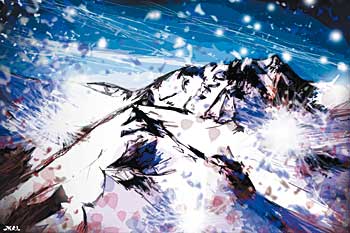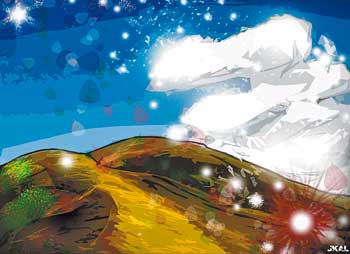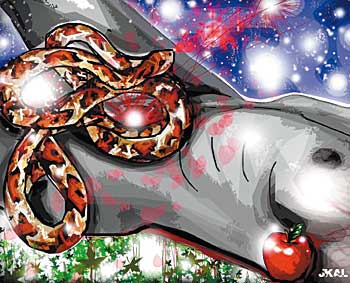 Warm weather is a time for games par excellence, inspired by the verve of renewed nature at its most vigorous. In my opinion, the mountain is one of the environments that offer the greatest temptation to play, during those idyllic moments that delight and strengthen the body and the mind. Yes, because playing is not only good for the body, but also for the spirit, which I like to define as the “thought of the soul”. And what I have now set out to do is create a game for the spirit, a divertissement induced by the effervescent and balsamic effect of the mountain air.
Warm weather is a time for games par excellence, inspired by the verve of renewed nature at its most vigorous. In my opinion, the mountain is one of the environments that offer the greatest temptation to play, during those idyllic moments that delight and strengthen the body and the mind. Yes, because playing is not only good for the body, but also for the spirit, which I like to define as the “thought of the soul”. And what I have now set out to do is create a game for the spirit, a divertissement induced by the effervescent and balsamic effect of the mountain air.
My unusual game revolves around the word “MONTAGNA” (MOUNTAIN), which can be read as an acrostic of the phrase “Mentre Osservo Natura, Tramonti Antichi Generano Nuove Albe” (“While I Observe Nature, Ancient Sunsets Generate New Dawns”). Almost a poem…
In fact, who has not experienced the sensation described by the poet who said, “While I was watching the dawn, evening fell”? Indeed, when admiring a mountain view, one can lose track of time so that “ancient sunsets” blend into “new dawns”, because up there, past and present – geology and history – seem to merge, rewarding us with unique impressions and feelings. For this reason the acronym of the related word “MONTE” (MOUNT) could be “Mentre Osservo Natura, Trovo Emozioni” (“I Feel Emotions While Observing Nature”).
The Italian language has always enjoyed “playing” with the terms mountain and mount too (both words are Latin in origin and derive from an Indo-European root word), using them in a whole range of curious expressions.
“Il parto della montagna” (“The mountain’s offspring”), for instance, refers to the modest or ridiculous outcome of an excessively ambitious undertaking (which reminds us of Aesop’s famous fable where the mountain gives birth to
a pathetic little mouse).
Then there are those of us who always have a “mountain” of things to do, like the mothers who have to wash a “mountain” of children’s clothes; the person who weighs like a mountain and who, alas, should go on a diet; the “man-mountain” who could work as a bouncer in a discotheque; those who love to ride on the “Russian mountain” (roller coaster) at the fair, a kind of miniature railway with very steep slopes; and finally there are those that suffer from “mountain sickness”, or altitude sickness, a condition involving circulatory and respiratory ailments that affects climbers who are unused to high altitudes (we hope they get over it, otherwise they will never know what they are missing). During the French Revolution, the Jacobin party acquired a great deal of power at the Assembly of the National Convention on 20th September 1792, and became known as The Mountain (La Montagne) as they occupied the highest benches in the hall.
coaster) at the fair, a kind of miniature railway with very steep slopes; and finally there are those that suffer from “mountain sickness”, or altitude sickness, a condition involving circulatory and respiratory ailments that affects climbers who are unused to high altitudes (we hope they get over it, otherwise they will never know what they are missing). During the French Revolution, the Jacobin party acquired a great deal of power at the Assembly of the National Convention on 20th September 1792, and became known as The Mountain (La Montagne) as they occupied the highest benches in the hall.
Let us “scendere a monte” (get to the root of the matter) and try to avoid behaving like certain politicians who promise “mari e monti” (make extravagant promises), and then fail to deliver anything, sometimes even “mandando a monte” (making a mess) of worthwhile projects and public works, which slowly but surely “vanno a monte” fail. The palmist must have a sound knowledge of mounts, as the protrusions on the palm that indicate a person’s character are defined. Whereas, those who have difficulty making ends meet know all too well what “Monti di Pietà”, or pawnshops, are. Although they might well rejoice if they were to win one of those gargantuan “monte-premi” (jackpots) in the lottery. Naturally, it’s important that they don’t blow the lot on bets and wagers, thereby increasing the “monte” (jackpot) again.
Card players, of course, are aware that the discarded cards are known as the “monte” (pile) and baseball players know that the “monte” (mound) refers to the raised area from where the pitcher  throws his pitches.
throws his pitches.
Gluttons, like me, must surely be aware of the Monte Bianco dessert, made with chestnuts and whipped cream, which bears such a strong resemblance to rocky, snow-covered Mont Blanc that crowns the Alps. And it is not only anatomists who know that the triangular area between the groin and the pubic fissure is known as the “monte di Venere” (Mount of Venus).
Furthermore, how many Italian place names contain the word “monte”? From Montebello to Montecassino, from Montecatini to Montepulciano, from Montichiari to Montefeltro, from Montecarlo to Monterosso, and so on.
“Monti” and “Montagne” also appear in surnames, including some famous people. How about the distinguished man of letters Vincenzo Monti (1754-1828), who Leopardi defined as the “poet of the imagination and the ear”? To say nothing of the Piemontese writer, Augusto Monti (1881-1996), the patriot and Garibaldi supporter, Giuseppe Monti (1845-1868), and the Veronese doctor and writer, Giovanni Battista Monte (1448-1551). Let us not forget Bartolomeo Montagna (1450 ca.-1523), the painter from Brescia, or the Vicentine engraver, Benedetto Montagna (1481 ca.-1558 ca.)
 Finally, between the mountains, there
are also valleys (from the Latin volvere, to turn) and those of us who love to roam unhindered, do not hesitate to “andare per monti e per valli” (“travel up hill and down dale”), albeit simply to admire (but not to pick) the charming “lilies of the valley”.
Finally, between the mountains, there
are also valleys (from the Latin volvere, to turn) and those of us who love to roam unhindered, do not hesitate to “andare per monti e per valli” (“travel up hill and down dale”), albeit simply to admire (but not to pick) the charming “lilies of the valley”.
If nothing else, the beauty of such places helps us to forget that we all live in a “valle di lacrime” (“vale of tears”), in this world that is so often filled with pain.
Even in a lagoon we may find “valli”,
i.e. sheets of water used for breeding fish and where, unfortunately, hunters ply their trade.
So, let us return to the Alps (a Latin term, whose original meaning was “white”) for a last salute to our dear Italy in the words of Petrarch, “il bel paese / ch’Appennin parte e ‘l mar circonda e l’Alpe” (“The beautiful land / divided by the Apennines and surrounded by the sea and the Alps”).
Kalvellido illustrations